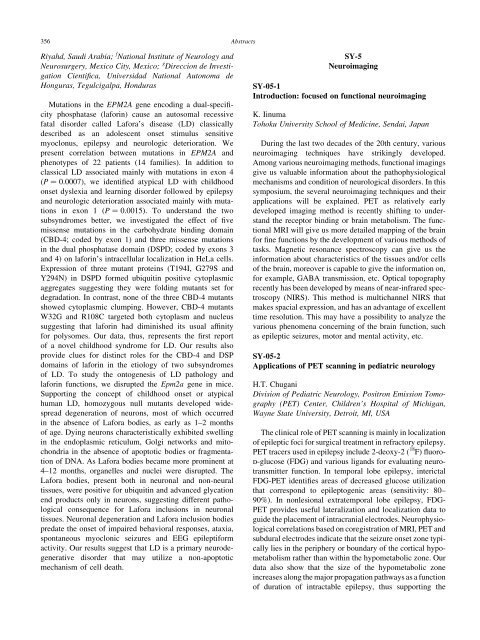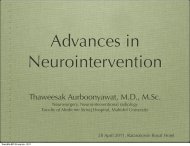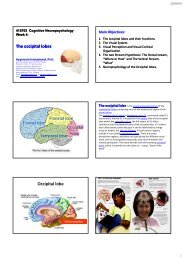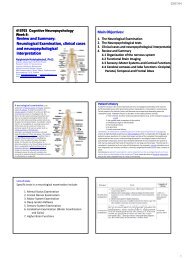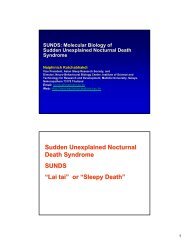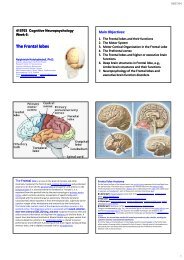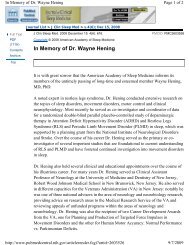PDF File - Mahidol University
PDF File - Mahidol University
PDF File - Mahidol University
Create successful ePaper yourself
Turn your PDF publications into a flip-book with our unique Google optimized e-Paper software.
356<br />
Abstracts<br />
Riyahd, Saudi Arabia; f National Institute of Neurology and<br />
Neurosurgery, Mexico City, Mexico; g Direccion de Investigation<br />
Cientifica, Universidad National Autonoma de<br />
Honguras, Tegulcigalpa, Honduras<br />
Mutations in the EPM2A gene encoding a dual-specificity<br />
phosphatase (laforin) cause an autosomal recessive<br />
fatal disorder called Lafora’s disease (LD) classically<br />
described as an adolescent onset stimulus sensitive<br />
myoclonus, epilepsy and neurologic deterioration. We<br />
present correlation between mutations in EPM2A and<br />
phenotypes of 22 patients (14 families). In addition to<br />
classical LD associated mainly with mutations in exon 4<br />
(P ¼ 0:0007), we identified atypical LD with childhood<br />
onset dyslexia and learning disorder followed by epilepsy<br />
and neurologic deterioration associated mainly with mutations<br />
in exon 1 (P ¼ 0:0015). To understand the two<br />
subsyndromes better, we investigated the effect of five<br />
missense mutations in the carbohydrate binding domain<br />
(CBD-4; coded by exon 1) and three missense mutations<br />
in the dual phosphatase domain (DSPD; coded by exons 3<br />
and 4) on laforin’s intracellular localization in HeLa cells.<br />
Expression of three mutant proteins (T194I, G279S and<br />
Y294N) in DSPD formed ubiquitin positive cytoplasmic<br />
aggregates suggesting they were folding mutants set for<br />
degradation. In contrast, none of the three CBD-4 mutants<br />
showed cytoplasmic clumping. However, CBD-4 mutants<br />
W32G and R108C targeted both cytoplasm and nucleus<br />
suggesting that laforin had diminished its usual affinity<br />
for polysomes. Our data, thus, represents the first report<br />
of a novel childhood syndrome for LD. Our results also<br />
provide clues for distinct roles for the CBD-4 and DSP<br />
domains of laforin in the etiology of two subsyndromes<br />
of LD. To study the ontogenesis of LD pathology and<br />
laforin functions, we disrupted the Epm2a gene in mice.<br />
Supporting the concept of childhood onset or atypical<br />
human LD, homozygous null mutants developed widespread<br />
degeneration of neurons, most of which occurred<br />
in the absence of Lafora bodies, as early as 1–2 months<br />
of age. Dying neurons characteristically exhibited swelling<br />
in the endoplasmic reticulum, Golgi networks and mitochondria<br />
in the absence of apoptotic bodies or fragmentation<br />
of DNA. As Lafora bodies became more prominent at<br />
4–12 months, organelles and nuclei were disrupted. The<br />
Lafora bodies, present both in neuronal and non-neural<br />
tissues, were positive for ubiquitin and advanced glycation<br />
end products only in neurons, suggesting different pathological<br />
consequence for Lafora inclusions in neuronal<br />
tissues. Neuronal degeneration and Lafora inclusion bodies<br />
predate the onset of impaired behavioral responses, ataxia,<br />
spontaneous myoclonic seizures and EEG epileptiform<br />
activity. Our results suggest that LD is a primary neurodegenerative<br />
disorder that may utilize a non-apoptotic<br />
mechanism of cell death.<br />
SY-5<br />
Neuroimaging<br />
SY-05-1<br />
Introduction: focused on functional neuroimaging<br />
K. Iinuma<br />
Tohoku <strong>University</strong> School of Medicine, Sendai, Japan<br />
During the last two decades of the 20th century, various<br />
neuroimaging techniques have strikingly developed.<br />
Among various neuroimaging methods, functional imagings<br />
give us valuable information about the pathophysiological<br />
mechanisms and condition of neurological disorders. In this<br />
symposium, the several neuroimaging techniques and their<br />
applications will be explained. PET as relatively early<br />
developed imaging method is recently shifting to understand<br />
the receptor binding or brain metabolism. The functional<br />
MRI will give us more detailed mapping of the brain<br />
for fine functions by the development of various methods of<br />
tasks. Magnetic resonance spectroscopy can give us the<br />
information about characteristics of the tissues and/or cells<br />
of the brain, moreover is capable to give the information on,<br />
for example, GABA transmission, etc. Optical topography<br />
recently has been developed by means of near-infrared spectroscopy<br />
(NIRS). This method is multichannel NIRS that<br />
makes spacial expression, and has an advantage of excellent<br />
time resolution. This may have a possibility to analyze the<br />
various phenomena concerning of the brain function, such<br />
as epileptic seizures, motor and mental activity, etc.<br />
SY-05-2<br />
Applications of PET scanning in pediatric neurology<br />
H.T. Chugani<br />
Division of Pediatric Neurology, Positron Emission Tomography<br />
(PET) Center, Children’s Hospital of Michigan,<br />
Wayne State <strong>University</strong>, Detroit, MI, USA<br />
The clinical role of PET scanning is mainly in localization<br />
of epileptic foci for surgical treatment in refractory epilepsy.<br />
PET tracers used in epilepsy include 2-deoxy-2 ( 18 F) fluorod-glucose<br />
(FDG) and various ligands for evaluating neurotransmitter<br />
function. In temporal lobe epilepsy, interictal<br />
FDG-PET identifies areas of decreased glucose utilization<br />
that correspond to epileptogenic areas (sensitivity: 80–<br />
90%). In nonlesional extratemporal lobe epilepsy, FDG-<br />
PET provides useful lateralization and localization data to<br />
guide the placement of intracranial electrodes. Neurophysiological<br />
correlations based on coregistration of MRI, PET and<br />
subdural electrodes indicate that the seizure onset zone typically<br />
lies in the periphery or boundary of the cortical hypometabolism<br />
rather than within the hypometabolic zone. Our<br />
data also show that the size of the hypometabolic zone<br />
increases along the major propagation pathways as a function<br />
of duration of intractable epilepsy, thus supporting the


